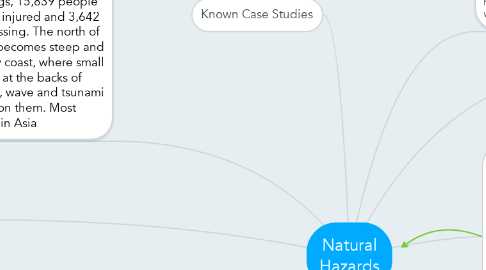Natural Hazards
by Sameera MEHTA

1. Impacts This Tsunami swept away Cars, Houses, Buildings, 15,839 people died,5950 were injured and 3,642 people were missing. The north of Sendai coast's becomes steep and rocky. It's a rocky coast, where small fishing towns sit at the backs of bays. As a result, wave and tsunami energy focuses on them. Most Tsunami's occur in Asia
2. prevention
3. Known Case Studies
4. Spatial Distribution Most earthquakes occur least in the atlantic ocean, Most volcanoes are located least in the atlantic ocean. We use “located” for volcanoes and “occur” for earthquakes because volcanoes are already located in certain areas and earthquakes are not so they just happen you normally can’t tell.
5. Definition A Tsunami is a unusually large sea wave produced by a seaquake or an undersea volcanic eruption.
6. Location Near East Coast of Honshu, Japan 2011
7. Causes The Tsunami was caused by the Japan trench it slipped by as much as 164 feet (50 meters). Most of the movement occurred horizontally. But because the plates are wedged together at this trench, that horizontal displacement still managed to thrust up enough seawater to produce the killer tsunami that hit Japan.
8. Protection The Army, If your in danger because of a Tsunami a good way to stay safe is to stay or shelter somewhere high up. e.g - Up a mountain where the water can't go.


